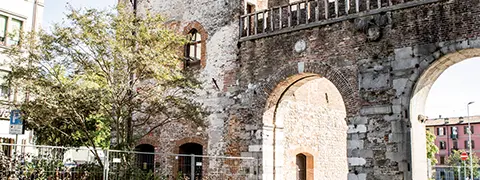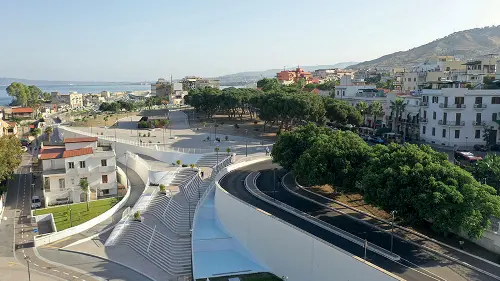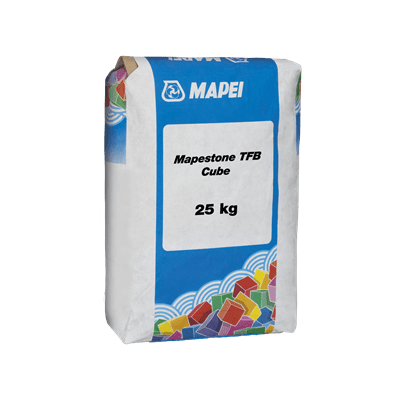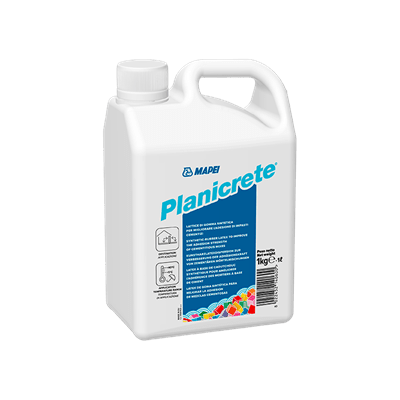

Projects
/
10/20/2025
San Salvo seafront: technology and durability for an outstanding redevelopment project
A pilot project for the Adriatic coast, with solutions from the Mapestone range for the installation of porcelain tile paving in marine environments
The refurbishment of the San Salvo Marina seafront, located in a section of the Adriatic coast known as the “Costa dei Trabocchi”, has created a new urban space that is more attractive and accessible for the local community. The project involved the use of porcelain tiles for the new paving, an unusual and ambitious choice for a coastal setting that has proved highly successful thanks to the use of the Mapestone system. Mapei technologies guaranteed rapid, safe installation in compliance with current standards, ensuring a high level of resistance to the harsh conditions of the marine environment. The project was completed in a short space of time and with attention to the landscape and now stands as a pilot model for coastal regeneration along the Adriatic Sea.
Located in the heart of the Costa dei Trabocchi, one of the most picturesque stretches of the Italian coastline named after its iconic wooden “fishing machines”, the San Salvo Marina seafront recently underwent major urban and environmental regeneration. The aim of the project was to remediate a section of coastal landscape that is popular with both residents and tourists and restore a space of strong social value for use by the community while providing it with a new morphological and functional identity. The project has transformed the appearance of one of the area’s busiest promenades, popular with locals and visitors alike. Built in the 1970s, the old San Salvo Marina seafront had remained almost unchanged for half a century but is now more accessible and durable and has a fresh, contemporary look.

The new porcelain tile paving along the San Salvo seafront was laid using the Mapestone system, which guarantees high resistance to sea spray.
The regeneration project
The project was led by Nicola Centofanti, who knows the local area well and sought to highlight its most distinctive features. The project was divided into three sections. Work on the first two sections began in late summer 2022 and was completed immediately after the summer of 2023, while work on the third section, involving regeneration of the green areas, is currently in progress and is expected to be completed by November 2025.
The work involved installing a total of 15,000 m2 of new paving. Scheduling had to take account of the tourist season, requiring rapid execution while also guaranteeing a long service life in a challenging marine environment.
As Centofanti explained in an interview with Realtà Mapei, “the project is unique not only for its technical complexity but also for its focus on nature, urban planning and durability”.
To ensure visual continuity across the various project sections, vehicle-resistant porcelain stoneware slabs were chosen for the new paving. The project is consequently a pilot scheme that combines care for the landscape with the use of advanced technology to install a material not normally chosen for this kind of application.
The Mapei solution
Mapei contributed to the project by supplying an innovative solution suitable for installing a material not normally used in a coastal environment. The challenges were overcome using the Mapestone system, a turnkey solution compliant with the UNI 11714-1:2018, the Italian standard for road paving. This system creates surfaces with a high level of resistance to freeze-thaw cycles, de-icing salts and sea spray while also allowing for rapid installation, exactly what was needed in the San Salvo Marina seafront project.
The process began with the creation of an installation screed with Mapestone TFB Cube, a premixed mortar ideal for screeds for architectural paving in exposure classes XF4 and XS3 as defined by EN 206 standard.

The porcelain slabs were laid using Mapestone TFB Cube mortar after applying a slurry made with Planicrete to the back of each slab.
Because the paving consisted of porcelain tiles, a layer of slurry created by mixing Planicrete synthetic rubber latex with water and cement was applied to the back of the slabs before they were laid onto the screed.
After laying, the joints were grouted with Mapestone PFS 2 FLEX, a ready-mixed mortar with low elastic modulus suitable for grouting architectural paving even under heavy traffic conditions, in compliance with Italian standard UNI 11714-1:2018.
The perimeter and expansion joints were sealed with Mapesil LM, a neutral silicone sealant capable of absorbing movements caused by thermal expansion and consequently suitable for outdoor use. The sealant was chosen in a colour that blends well with the paving.
The combined use of Mapestone system products created a durable monolithic structure for the new paving of the San Salvo Marina seafront. In addition to resistance to de-icing salts, freeze-thaw cycles and seawater, paving installed with the Mapestone system also stand out for their high compressive strength and long service life.
Thanks to the contribution of the Mapestone system, the San Salvo Marina seafront now stands as a model of coastal urban regeneration that combines innovative materials with respect for the landscape and environmental sustainability. It demonstrates how technology and integrated design can restore value, identity and beauty to a public space that is not only important for the life of the local community but is also very popular with visitors.

The Mapestone system met the design requirements of this innovative project, ensuring durability, resistance to aggressive agents and high aesthetic impact.















